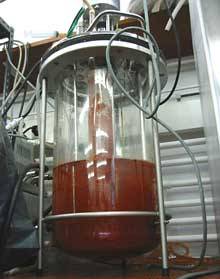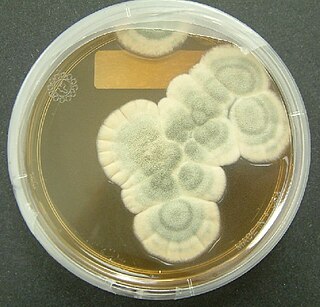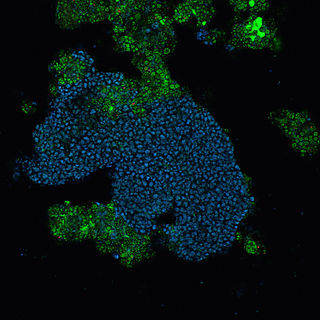
Acidobacteriota is a phylum of Gram-negative bacteria. Its members are physiologically diverse and ubiquitous, especially in soils, but are under-represented in culture.

Anammox, an abbreviation for "anaerobic ammonium oxidation", is a globally important microbial process of the nitrogen cycle that takes place in many natural environments. The bacteria mediating this process were identified in 1999, and were a great surprise for the scientific community. In the anammox reaction, nitrite and ammonium ions are converted directly into diatomic nitrogen and water.
The fumonisins are a group of mycotoxins derived from Fusarium and their Liseola section. They have strong structural similarity to sphinganine, the backbone precursor of sphingolipids.

γ-Glutamylmethylamide is an amino acid analog of the proteinogenic amino acids L-glutamic acid and L-glutamine, found primarily in plant and fungal species; simply speaking, it is L-glutamine methylated on the amide nitrogen. It is an identified important biosynthetic intermediate allowing bacteria use of methylated amines as carbon and nitrogen source for growth. Like its close relative theanine, it is a pharmacologically active constituent of green tea, with preliminary evidence for at least comparable activity to theanine as a hypotensive.
The Gemmatimonadota are a phylum of bacteria established in 2003. The phylum contains two classes Gemmatimonadetes and Longimicrobia.

Class II bacteriocins are a class of small peptides that inhibit the growth of various bacteria.
Sakacins are bacteriocins produced by Lactobacillus sakei. They are often clustered with the other lactic acid bacteriocins. The best known sakacins are sakacin A, G, K, P, and Q. In particular, sakacin A and P have been well characterized.
In mycology, acanthocyte refers to stellate cells found on the hyphae of fungi of the genus Stropharia. Recent work, published in 2006, on those of Stropharia rugosoannulata has shown them to have nematode-killing properties.

The rsmX gene is part of the Rsm/Csr family of non-coding RNAs (ncRNAs). Members of the Rsm/Csr family are present in a diverse range of bacteria, including Escherichia coli, Erwinia, Salmonella, Vibrio and Pseudomonas. These ncRNAs act by sequestering translational repressor proteins, called RsmA, activating expression of downstream genes that would normally be blocked by the repressors. Sequestering of target proteins is dependent upon exposed GGA motifs in the stem loops of the ncRNAs. Typically, the activated genes are involved in secondary metabolism, biofilm formation and motility.

Penicillium chrysogenum is a species of fungus in the genus Penicillium. It is common in temperate and subtropical regions and can be found on salted food products, but it is mostly found in indoor environments, especially in damp or water-damaged buildings. It has been recognised as a species complex that includes P. notatum, P. meleagrinum, and P. cyaneofulvum, but molecular phylogeny established that it is a distinct species and that P. notatum is P. rubens. It has rarely been reported as a cause of human disease. It is the source of several β-lactam antibiotics, most significantly penicillin. Other secondary metabolites of P. chrysogenum include roquefortine C, meleagrin, chrysogine, 6-MSA YWA1/melanin, andrastatin A, fungisporin, secalonic acids, sorbicillin, and PR-toxin.

2,4-Diacetylphloroglucinol or Phl is a natural phenol found in several bacteria:

Candidatus Accumulibacter phosphatis (CAP) is an unclassified type of Betaproteobacteria that is a common bacterial community member of sewage treatment and wastewater treatment plants performing enhanced biological phosphorus removal (EBPR) and is a polyphosphate-accumulating organism. The role of CAP in EBPR was elucidated using culture-independent approaches such as 16S rRNA clone banks that showed the Betaproteobacteria dominated lab-scale EBPR reactors. Further work using clone banks and fluorescence in situ hybridization identified a group of bacteria, closely related to Rhodocyclus as the dominant member of lab-scale communities.

Rhamnolipids are a class of glycolipid produced by Pseudomonas aeruginosa, amongst other organisms, frequently cited as bacterial surfactants. They have a glycosyl head group, in this case a rhamnose moiety, and a 3-(hydroxyalkanoyloxy)alkanoic acid (HAA) fatty acid tail, such as 3-hydroxydecanoic acid.

Bacteriocin AS-48 is a cyclic peptide antibiotic produced by the eubacteria Enterococcus faecalis that shows a broad antimicrobial spectrum against both Gram-positive and Gram-negative bacteria. Bacteriocin AS-48 is encoded by the pheromone-responsive plasmid pMB2, and acts on the plasma membrane in which it opens pores leading to ion leakage and cell death. The globular structure of bacteriocin AS-48 is composed of five alpha helices enclosing a hydrophobic core. The mammalian NK-lysin effector protein of T and natural killer cells has a similar structure, though it lacks sequence homology with bacteriocins AS-48.
Myceliophthora thermophila is an ascomycete fungus that grows optimally at 45–50 °C (113–122 °F). It efficiently degrades cellulose and is of interest in the production of biofuels. The genome has recently been sequenced, revealing the full range of enzymes this organism uses for the degradation of plant cell wall material.
Methanosaeta concilii is an archaeum in the disputed genus Methanosaeta. It is obligately anaerobic, gram-negative and non-motile. It is rod-shaped with flat ends. The cells are enclosed within a cross-striated sheath. The type strain is GP6. Its genome has been sequenced.
Streptomyces isolates have yielded the majority of human, animal, and agricultural antibiotics, as well as a number of fundamental chemotherapy medicines. Streptomyces is the largest antibiotic-producing genus of Actinomycetota, producing chemotherapy, antibacterial, antifungal, antiparasitic drugs, and immunosuppressants. Streptomyces isolates are typically initiated with the aerial hyphal formation from the mycelium.
The Holosporales are an order of bacteria.

Eugene Rosenberg is a microbiologist at the Faculty of Life Sciences at Tel Aviv University, an expert in the field of applied environmental microbiology, in particular his work on Myxobacteria, microorganisms to combat pollution (bioremediation), and the Hologenome theory of evolution.
Dokdonia donghaensis is a strictly aerobic, gram-negative, phototrophic bacterium that thrives in marine environments. The organism can grow at a broad range of temperatures on seawater media. It has the ability to form biofilms, which increases the organism's resistance to antimicrobial agents, such as tetracycline.












